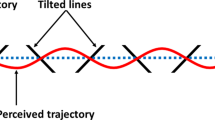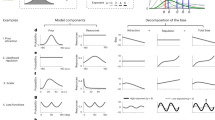Abstract
THE illusory expansion of acute angles has long been suspected to be an important contributory factor in a number of well known illusions, such as the Zollner, the Wundt–Hering and the Poggendorf1,2. Recently Blakemore, Carpenter and Georgeson3 proposed that angle expansion is a side effect of an inhibitory process that improves the orientation resolution of the visual system. Neural line and edge detectors considered in isolation, are assumed to respond to a wide range of orientations, but when incorporated into a functional system inhibitory interactions occur between them which sharpen the specification of a line or edge4. When two spatially contiguous lines of neighbouring orientations are exposed simultaneously, however, the activity peaks in the population of orientation detectors are shifted away from each other because of the inhibitory interactions. Consequently, the orientations of the lines comprising the angle are perceived wrongly. This process of central lateral inhibition is thought to be similar to that which operates in peripheral sensory structures3. It seems natural to ask how far this similarity extends.
This is a preview of subscription content, access via your institution
Access options
Subscribe to this journal
Receive 51 print issues and online access
$199.00 per year
only $3.90 per issue
Buy this article
- Purchase on Springer Link
- Instant access to full article PDF
Prices may be subject to local taxes which are calculated during checkout
Similar content being viewed by others
References
Helmholtz, H. von, Treatise on Physiological Optics, 111 (Dover, New York, 1962).
Robinson, J. O., The Psychology of visual illusion (Hutchinson, London, 1972).
Blakemore, C., Carpenter, R. H. S., and Georgeson, M. A., Nature, 228, 37 (1970).
Andrews, D. P., Nature, 205, 1218 (1965).
Hartline, H. E., Wagner, H. G., and Ratcliff, F., J. gen. Physiol., 39, 651 (1956).
Ganz, L., Psychol. Rev., 73, 128 (1966).
Carpenter, R. H. S., and Blakemore, C., Expl Brain Res., 18, 287 (1973).
Oyama, T., Psychologia, 3, 7 (1960).
Wallace, G. K., and Crampin, A. J., Vision Res., 167 (1969).
Diamond, A. L., J. exp. Psychol., 45, 304 (1953).
Parker, D. M., Q., J. exp. Psychol., 24, 1 (1972).
Georgeson, M. A., Nature, 245, 43 (1973).
Campbell, F. W., and Maffei, L., Vision Res., 11, 833 (1971).
Day, R. H., Science, 175, 1335 (1972).
Author information
Authors and Affiliations
Rights and permissions
About this article
Cite this article
PARKER, D. Evidence for the inhibition hypothesis in expanded angle illusion. Nature 250, 265–266 (1974). https://doi.org/10.1038/250265a0
Received:
Revised:
Issue Date:
DOI: https://doi.org/10.1038/250265a0
Comments
By submitting a comment you agree to abide by our Terms and Community Guidelines. If you find something abusive or that does not comply with our terms or guidelines please flag it as inappropriate.



